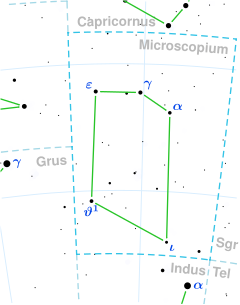HD 194783
| Observation data Epoch J2000.0 Equinox J2000.0 (ICRS) | |
|---|---|
| Constellation | Microscopium |
| Right ascension | 20h 28m 46.74360s[1] |
| Declination | −35° 35′ 45.1068″[1] |
| Apparent magnitude (V) | 6.08±0.01[2] |
| Characteristics | |
| Spectral type | B8 II/III[3] or B9pHgMn[4] |
| B−V color index | −0.11[5] |
| Astrometry | |
| Radial velocity (Rv) | −9.7±1.2[6] km/s |
| Proper motion (μ) | RA: +2.959 mas/yr[1] Dec.: −21.638 mas/yr[1] |
| Parallax (π) | 4.3936 ± 0.0714 mas[1] |
| Distance | 740 ± 10 ly (228 ± 4 pc) |
| Absolute magnitude (MV) | −0.59[7] or −1.10[8] |
| Details | |
| Mass | 4.03±0.05[1] M☉ |
| Radius | 4.19±0.21[9] R☉ |
| Luminosity | 390±12[1] L☉ |
| Surface gravity (log g) | 3.75[10] cgs |
| Temperature | 14,028[8] K |
| Metallicity [Fe/H] | −0.20[10] dex |
| Rotation | 6 d[11] |
| Rotational velocity (v sin i) | ≤30[11] km/s |
| Age | 70[8] Myr |
| Other designations | |
| Database references | |
| SIMBAD | data |
HD 194783 (HR 7817; 2 G. Microscopii) is a solitary star located in the southern constellation Microscopium near the border with Sagittarius. It is barely visible to the naked eye as a bluish-white-hued point of light with an apparent magnitude of 6.08.[2] The object is located relatively far at a distance of 740 light-years based on Gaia DR3 parallax measurements,[1] but it is drifting closer with a heliocentric radial velocity of −9.7 km/s.[6] At its current distance, HD 194783's brightness is diminished by an interstellar extinction of 0.31 magnitudes[14] and it has an absolute magnitude of either −0.59 or −1.10,[7][8] depending on the source.
HD 194783 has a stellar classification of B8 II/III,[3] indicating that it is an evolved B-type star with the blended luminosity class of a bright giant and a lower luminosity giant star. It has also been given a class of B9pHgMn,[4] indicating that it is a chemically peculiar mercury-manganese star. It has 4.03 times the mass of the Sun[1] and a slightly enlarged radius 4.19 times that of the Sun's.[9] It radiates 390 times the luminosity of the Sun[1] from its photosphere at an effective temperature of 14,028 K.[8] The heavy metal (iron) to hydrogen ratio–what astronomers dub as the star's metallicity–is 63% that of the Sun's.[10] HD 194783 is estimated to be approximately 70 million years old.[8]
In 1989, HD 194783 was reported to be a spectrum variable with a period of 6 days. The projected rotational velocity of the star is not known, but it is said to be no higher than 30 km/s.[11] HD 194783 was also observed to have a relatively weak magnetic field of about −43 gauss.[15]
References[edit]
- ^ a b c d e f g h i Vallenari, A.; et al. (Gaia collaboration) (2023). "Gaia Data Release 3. Summary of the content and survey properties". Astronomy and Astrophysics. 674: A1. arXiv:2208.00211. Bibcode:2023A&A...674A...1G. doi:10.1051/0004-6361/202243940. S2CID 244398875. Gaia DR3 record for this source at VizieR.
- ^ a b Høg, E.; Fabricius, C.; Makarov, V. V.; Urban, S.; Corbin, T.; Wycoff, G.; Bastian, U.; Schwekendiek, P.; Wicenec, A. (March 2000). "The Tycho-2 catalogue of the 2.5 million brightest stars". Astronomy and Astrophysics. 355: L27–L30. Bibcode:2000A&A...355L..27H. ISSN 0004-6361. S2CID 17128864.
- ^ a b Houk, N. (1982). Michigan Catalogue of Two-dimensional Spectral Types for the HD stars. Declinations −40° to −26°. Vol. 3. Bibcode:1982mcts.book.....H.
- ^ a b Andersen, J.; Nordstrom, B. (September 1977). "Bright southern stars of astrophysical interest". Astronomy and Astrophysics Supplement Series. 29: 309–312. Bibcode:1977A&AS...29..309A. ISSN 0365-0138.
- ^ Corben, P. M. (April 1971). "Photoelectric Magnitudes and Colours for Bright Southern Stars". Monthly Notes of the Astronomical Society of South Africa. 30 (4): 37. Bibcode:1971MNSSA..30...37C. ISSN 0024-8266.
- ^ a b Gontcharov, G. A. (November 2006). "Pulkovo Compilation of Radial Velocities for 35,495 Hipparcos stars in a common system". Astronomy Letters. 32 (11): 759–771. arXiv:1606.08053. Bibcode:2006AstL...32..759G. doi:10.1134/S1063773706110065. eISSN 1562-6873. ISSN 1063-7737. S2CID 119231169.
- ^ a b Anderson, E.; Francis, Ch. (May 2012). "XHIP: An extended hipparcos compilation". Astronomy Letters. 38 (5): 331–346. arXiv:1108.4971. Bibcode:2012AstL...38..331A. doi:10.1134/S1063773712050015. eISSN 1562-6873. ISSN 1063-7737. S2CID 119257644.
- ^ a b c d e f Westin, T. N. G. (April 1985). "The local system of early type stars. Spatial extent and kinematics". Astronomy and Astrophysics Supplement Series. 60: 99–134. Bibcode:1985A&AS...60...99W. ISSN 0365-0138. S2CID 119020376.
- ^ a b Kervella, P.; Thévenin, F.; Di Folco, E.; Ségransan, D. (April 8, 2004). "The angular sizes of dwarf stars and subgiants: Surface brightness relations calibrated by interferometry". Astronomy & Astrophysics. 426 (1): 297–307. arXiv:astro-ph/0404180. Bibcode:2004A&A...426..297K. doi:10.1051/0004-6361:20035930. eISSN 1432-0746. ISSN 0004-6361. S2CID 6077801.
- ^ a b c Anders, F.; et al. (February 2022). "Photo-astrometric distances, extinctions, and astrophysical parameters for Gaia EDR3 stars brighter than G = 18.5". Astronomy & Astrophysics. 658: A91. arXiv:2111.01860. Bibcode:2022A&A...658A..91A. doi:10.1051/0004-6361/202142369. eISSN 1432-0746. ISSN 0004-6361.
- ^ a b c Rajamohan, R.; Paranjpye, A. (1989). "The Spectrum Variable HR 7817 = HD 194783". Information Bulletin on Variable Stars. 3284: 1. Bibcode:1989IBVS.3284....1R. ISSN 0374-0676.
- ^ Gould, Benjamin Apthorp (1878). "Uranometria Argentina : brillantez y posicion de las estrellas fijas, hasta la septima magnitud, comprendidas dentro de cien grados del polo austral : con atlas". Resultados del Observatorio Nacional Argentino. 1. Bibcode:1879RNAO....1.....G.
- ^ "HD 194783". SIMBAD. Centre de données astronomiques de Strasbourg. Retrieved December 3, 2023.
- ^ Gontcharov, George A.; Mosenkov, Aleksandr V. (28 September 2017). "Verifying reddening and extinction for Gaia DR1 TGAS main sequence stars". Monthly Notices of the Royal Astronomical Society. 472 (4): 3805–3820. arXiv:1709.01160. Bibcode:2017MNRAS.472.3805G. doi:10.1093/mnras/stx2219. eISSN 1365-2966. ISSN 0035-8711. S2CID 118879856.
- ^ Hubrig, S.; North, P.; Schöller, M.; Mathys, G. (2006). "Evolution of magnetic fields in stars across the upper main sequence: I. Catalogue of magnetic field measurements with FORS 1 at the VLT". Astronomische Nachrichten. 327 (4): 289–297. arXiv:astro-ph/0603610. Bibcode:2006AN....327..289H. doi:10.1002/asna.200610535. ISSN 0004-6337. S2CID 16248930.

